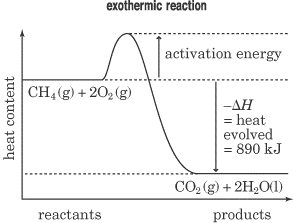Lesson: Chapter - 9
Enthalpy
Often chemical changes result in either the release or the absorption of heat,
and this change in heat in the system is measured in terms of the system’s
enthalpy (H). A reaction in which there is a net
absorption of heat energy is called an endothermic reaction, and in this
type of reaction energy is a reactant, and the change in enthalpy of the system,
DH, has a positive value.
A reaction in which there is a net production
of heat by the system is called an exothermic reaction. In this type of
reaction, energy is a product, and the change in enthalpy of the system, DH,
has a negative value. The figure below shows an exothermic reaction—you can see
that the products have lower energy than the reactants and that the DH of
the reaction has a positive value—890 kJ.

There are several different forms of enthalpy you might encounter on the SAT II
Chemistry exam, so make sure to study the following list so nothing surprises
you on test day.
- Enthalpy of reaction (DHrxn)—The
amount of heat absorbed or released by the chemical reaction
- Enthalpy of combustion (DHcomb)—The
amount of heat absorbed or released by combustion (burning; usually in the
presence of O2)
- Enthalpy of formation (DHf)—The
amount of heat absorbed or released when 1 mole of a compound is formed from
elements in their standard states
- Enthalpy of fusion (DHfus)—The
amount of heat that must be absorbed to melt 1 mole of solid to liquid at the
normal melting point
- Enthalpy of vaporization (DHvap)—The
amount of heat that must be absorbed to change 1 mole of liquid to gas at the
normal boiling point
Some final notes about enthalpy before we move on. First of all, enthalpy
is a state function, meaning that its value is fixed when temperature, pressure,
composition, and physical form are specified. Second, at a constant pressure, DH
= q, meaning that at constant pressure, the enthalpy of a system is equal
to the heat, in joules, of a system. Finally, the enthalpy changes of a reaction
can be calculated in several ways, including by using stoichiometry,
calorimetry, tables of standard values, Hess’s law, and the bond energies of the
substances involved. Let’s now move on to determining DH values of
systems using the above methods.
Next to display next topic in the chapter.
Practice Questions
Test Prep Lessons With Video Lessons and Explained MCQ
Large number of solved practice MCQ with explanations. Video Lessons and 10 Fully explained Grand/Full Tests.